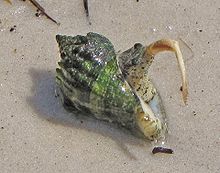- Melongena
-
Melongena
Temporal range: Late Miocene-Recent[1]
A live individual of Melongena corona righting itself by using its operculum Scientific classification Kingdom: Animalia Phylum: Mollusca Class: Gastropoda (unranked): clade Caenogastropoda
clade Hypsogastropoda
clade NeogastropodaSuperfamily: Buccinoidea Family: Melongenidae Subfamily: Melongeninae Genus: Melongena
Schumacher, 1817[2]Synonyms[3] Galeodes Röding, 1798 (non Olivi, 1791)
Melongena is a genus of sea snails, marine gastropod mollusks in the family Melongenidae, the crown conches and their allies.[3]
Contents
Species
Species within the genus Melongena include:[4]
- Melongena bicolor (Say, 1826)
- Melongena bispinosa (Philippi, 1844)
- Melongena californica Anderson & Martin, 1914
- Melongena corona (Gmelin, 1791) - crown conch - synonym: Melongena subcoronata
- Melongena melongena (Linnaeus, 1758) - type species[5]
- Melongena patula (Linnaeus, 1758)
- Melongena sprucecreekensis Tucker, 1994
- † Melongena woodwardi (Roxo, 1924) - from Miocene of the Pebas Formation[5]
synonyms:
- Melongena paradisaica (Röding, 1798) is a synonym of Volema paradisiaca Röding, 1798
- Melongena paradisiaca (Röding, 1798) is a synonym of Volema paradisiaca Röding, 1798
- Melongena pirum Dautzenberg, 1929 is a synonym of Volema pyrum (Gmelin, 1791)
The shells of Melongena species are extremely variable in shape and sculpture, and historically this has meant that a large number of different forms have been named, creating numerous synonyms.There is still some disagreement about how many modern species of Melongena actually exist. However, phylogenetic analysis indicate that there are only three species in the Western Atlantic, with all snails in coastal Florida being referred to Melongena corona.[6]
Distribution
The genus Melongena occurs only in the tropical Americas. It appears that three nominally valid species occur in the tropics of the western Atlantic: one in Florida, one in the Yucatan, and one in Central America and the Caribbean. A fourth species is found on the tropical eastern Pacific coast.
Habitat
Species within this genus live in the tropical intertidal zone, in muddy areas such as under mangrove trees.
Life habits
Melongena snails are carnivorous, primarily preying on small bivalves (clams, mussels and oysters). They will also feed on other species of snails and have been known to be cannibalistic.[6]
References
- ^ Wesselingh F. P., Anderson L. C. & Kadolsky D. (2006). "Molluscs from the Miocene Pebas Formation of Peruvian and Colombian Amazonia". Scripta Geologica 1333: 19-290. PDF.
- ^ Schumacher (1817). Ess. Vers test. 64: 212.
- ^ a b WoRMS (2010). Melongena Schumacher, 1817. In: Bouchet, P.; Gofas, S.; Rosenberg, G. (2010) World Marine Mollusca database. Accessed through: World Register of Marine Species at http://www.marinespecies.org/aphia.php?p=taxdetails&id=205587 on 2011-04-02
- ^ "Melongena". Integrated Taxonomic Information System. http://www.itis.gov/servlet/SingleRpt/SingleRpt?search_topic=TSN&search_value=74100.
- ^ a b Vermeij J. & Wesselingh F. P. (2002). "Neogastropod molluscs from the Miocene of western Amazonia, with comments on marine to freshwater transitions in molluscs". Journal of Paleontology 76(2): 265-270. doi:10.1666/0022-3360(2002)076<0265:NMFTMO>2.0.CO;2.
- ^ a b Hayes, K. A., 2003. Phylogeography and Evolution of the Florida Crown Conch (Melongena corona) MS Thesis University of South Florida, Department of Biology.
Further reading
- Abbott, R. Tucker, 1986. Seashells of North America, St. Martin's Press, New York
- Keen, A. Myra, 1971. Sea shells of tropical west America, Stanford University Press, Stanford, California
- Anderson, F.M., and B. Martin, 1914. "Neocene records in the Temblor Basin, California, and Neocene deposits of the San Juan District, San Luis Obispo County", California Academy of Sciences Proceedings, 4th series, v. IV, p. 14-112.
External links
Categories:
Wikimedia Foundation. 2010.
